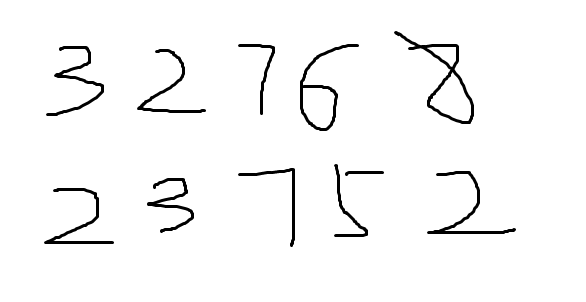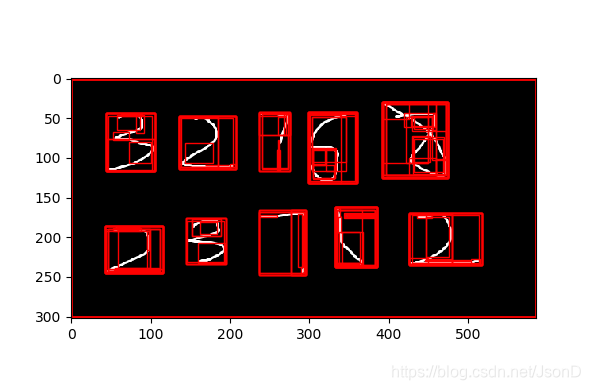注:本文使用的语言是Python3
程序引入包
import cv2
import selectivesearch
import matplotlib.pyplot as plt
import matplotlib.patches as mpatches
import numpy as np
原始图片为拿画板随便写的几个数字

第一步操作:执行搜索工具,展示搜索结果
image2="images/test2.png"
#用cv2读取图片
img = cv2.imread(image2,cv2.IMREAD_UNCHANGED)
#白底黑字图 改为黑底白字图
img=255-img
'''selectivesearch 调用selectivesearch函数 对图片目标进行搜索
#Parameters
----------
im_orig : 类型ndarray
Input image
输入图片
scale : int
Free parameter. Higher means larger clusters in felzenszwalb segmentation.
自由参数。在felzenszwalb分割中,较高的聚类数意味着较大的聚类数。
sigma : float
Width of Gaussian kernel for felzenszwalb segmentation.
用于felzenszwalb分割的高斯核宽度。
min_size : int
Minimum component size for felzenszwalb segmentation.
felzenszwalb分割的最小分量大小
'''
img_lbl, regions =selectivesearch.selective_search(img, scale=500, sigma=0.9, min_size=20)
print (regions[0])
print (len(regions)) #共搜索到199个区域
# 接下来我们把窗口和图像打印出来,对它有个直观认识
fig, ax = plt.subplots(ncols=1, nrows=1, figsize=(6, 4))
ax.imshow(img)
for reg in regions:
x, y, w, h = reg['rect']
rect = mpatches.Rectangle((x, y), w, h, fill=False, edgecolor='red', linewidth=1)
ax.add_patch(rect)
plt.show()
搜索完成后展示所有搜索窗

第二步操作:过滤掉冗余的窗口
#1)第一次过滤
candidates = []
for r in regions:
# 重复的不要
if r['rect'] in candidates:
continue
# 太小和太大的不要
if r['size'] < 200 or r['size']>20000:
continue
x, y, w, h = r['rect']
# 太不方的不要
if w / h > 1.5 or h / w > 2.0: #根据实际情况调整
continue
candidates.append((x,y,w,h))
##('len(candidates)', 34) 一次过滤后剩余34个窗
print ('len(candidates)',len(candidates))
#2)第二次过滤 大圈套小圈的目标 只保留大圈
num_array=[]
for i in candidates:
if len(num_array)==0:
num_array.append(i)
else:
content=False
replace=-1
index=0
for j in num_array:
##新窗口在小圈 则滤除
if i[0]>=j[0] and i[0]+i[2]<=j[0]+j[2] and i[1]>=j[1] and i[1]+i[3]<=j[1]+j[3]:
content=True
break
##新窗口不在小圈 而在老窗口外部 替换老窗口
elif i[0]<=j[0] and i[0]+i[2]>=j[0]+j[2] and i[1]<=j[1] and i[1]+i[3]>=j[1]+j[3]:
replace=index
break
index+=1
if not content:
if replace>=0:
num_array[replace]=i
else:
num_array.append(i)
#窗口过滤完之后的数量
len=len(num_array)
#二次过滤后剩余10个窗
print('len====',len)
#3)对过滤完的窗口进行展示
fig, ax = plt.subplots(ncols=1, nrows=1, figsize=(6, 4))
ax.imshow(img)
for x, y, w, h in num_array:
rect = mpatches.Rectangle(
(x, y), w, h, fill=False, edgecolor='red', linewidth=1)
ax.add_patch(rect)
plt.show()过滤完成后剩余10个窗口

第三步操作:顺序提取图片上的数字
#搜索完后的窗口,上下是有序的 左右是无序的,所以上下分别进行排序 并合并
L1=num_array[0:len//2] #上边5个数字
L2=num_array[len//2:] #下边5个数字
L1.sort(key=lambda x:x[0]) ##上半部分排序
print ('sorted L1==',L1)
L2.sort(key=lambda x:x[0]) ##下半部分排序
print('sorted L2',L2)
L1.extend(L2)
print ("最终筛选后的窗口是:",L1)
#提取窗口图片后转化为28*28的标准图
Width=28
Height=28
#横向图片数组
img_sample = np.zeros((len, Width*Height))
i = 0
##数字截取、方块补全、统一resize 28X28
for rect in L1:
x, y, w, h = rect
#大图中截图窗口图片
img_cut = img[y :y+h, x:x +w,:]
#截取后的小图添加padding 生成方形图
if w > h:
real_size=w
else:
real_size=h
top_padding=(real_size - h) // 2
left_padding=(real_size - w)//2
#加padding方法
img_cut = cv2.copyMakeBorder(img_cut,top_padding,top_padding,left_padding,left_padding,borderType=cv2.BORDER_REPLICATE)
#把方形图 压缩成28*28的图
img_resize = cv2.resize(img_cut, (Width, Height), interpolation=cv2.INTER_NEAREST)
#压缩后的图转化成灰度图
gray = cv2.cvtColor(img_resize, cv2.COLOR_BGR2GRAY)
#生成的小图保存到本地
cv2.imwrite('images/img_'+str(i)+'.png',gray)
#生成的小图展平 放到img_sample里
img_sample[i, :] = gray.ravel()
i += 1
#把转换后的数据用长图来显示
img_s = np.zeros((Width, Height * img_sample.shape[0]))
for i in range(img_sample.shape[0]):
img_s[:, i * Width:Height * (i + 1)] =img_sample[i, :].reshape(Width, Height)
fig, ax = plt.subplots(ncols=1, nrows=1, figsize=(6, 2))
ax.imshow(img_s, cmap='gray')
plt.savefig("images/number.jpg", bbox_inch="tight")
plt.show()顺序提取结果展示:

注:接下来可以使用训练好的模型来识别这些提取出来的图片,例如mnist数据集的训练模型。
完整代码github地址:https://github.com/18600130137/selective_search.git








 本文介绍了一种基于Python的目标检测方法,通过Selective Search算法从图片中筛选出可能包含数字的区域,并进一步过滤和排序,最终提取出清晰的数字图像。
本文介绍了一种基于Python的目标检测方法,通过Selective Search算法从图片中筛选出可能包含数字的区域,并进一步过滤和排序,最终提取出清晰的数字图像。
















 541
541

 被折叠的 条评论
为什么被折叠?
被折叠的 条评论
为什么被折叠?








